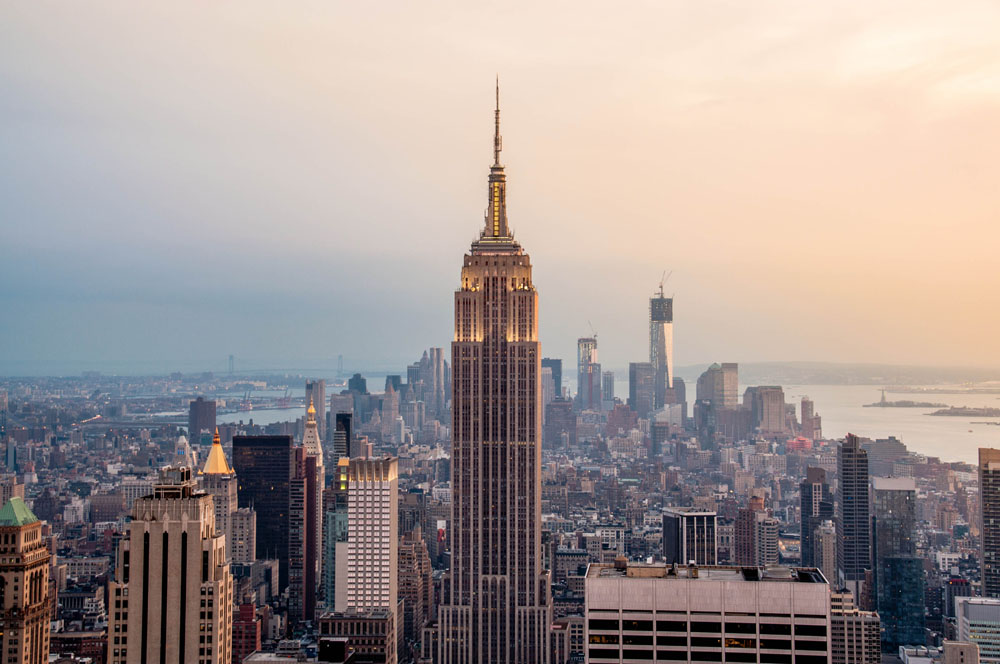
Empire State Building
No visit to New York City would be complete without a stop at this masterpiece of Art Deco design, and perhaps the most famous office building in the world. From its magnificent lobby — now sporting a re-creation of its original spectacular ceiling mural — to the 86th floor observatory perched more than 1,000 feet (305 meters) above the city streets, this National Historic Landmark gives visitors plenty to admire.
History
Completed in 1931, the building has a roof height of 1,250 feet (380m) and stands a total of 1,454 feet (443.2m) tall, including its antenna. The original design of the Empire State Building was a for a 50 story office building. However, after fifteen revisions, the final design was for an 86 story 1,250-foot building, with an airship mast on top. This ensured it would be the world's tallest building,
What to Do?
Open past midnight 365 days a year, it’s a wonderful place to look over New York City. Take the audio tour to learn more about everything you can see from the observation deck. The 80th floor is home to the Dare to Dream exhibit, featuring original documents, sketches, reproduction photos and other artefacts that capture the building's history. Observatories are located on the 86th and 102nd floors.
What to See?
On a clear day, the view encompasses five states. You'll get a clear view of many famous New York landmarks such as the Brooklyn Bridge, Times Square, Statue of Liberty, The Hudson and East River, and more. It's no wonder that this is one of the top places to visit in New York.

History
A stirring symbol of freedom, the copper Statue of Liberty on Ellis Island has been a beacon in New York Harbour since 1886. A gift from the people of France, the Statue was designed by Frédéric Auguste Bartholdi and built by Gustave Eiffel. The statue’s full name is Liberty Enlightening the World. The robed female figure represents Libertas, the Roman goddess of freedom. She holds a torch and tablet upon which is inscribed the date of American Declaration of Independence (July 4, 1776). From the ground to the top of the torch the statue measures 93 metres, and weighs 204 metric tonnes. Lady Liberty wears a size 879 shoe and has a 35 foot (10.67 m) waistline!
The only way to get there is on one of the commercial ferries – the journey gives you a fabulous photo opportunity as you approach the Island!
What to Do?
If you have the energy, climb the 354 stairs to reach the statue’s crown. There are 25 windows in the crown giving you a wonderful view over New York city and its skyscrapers..
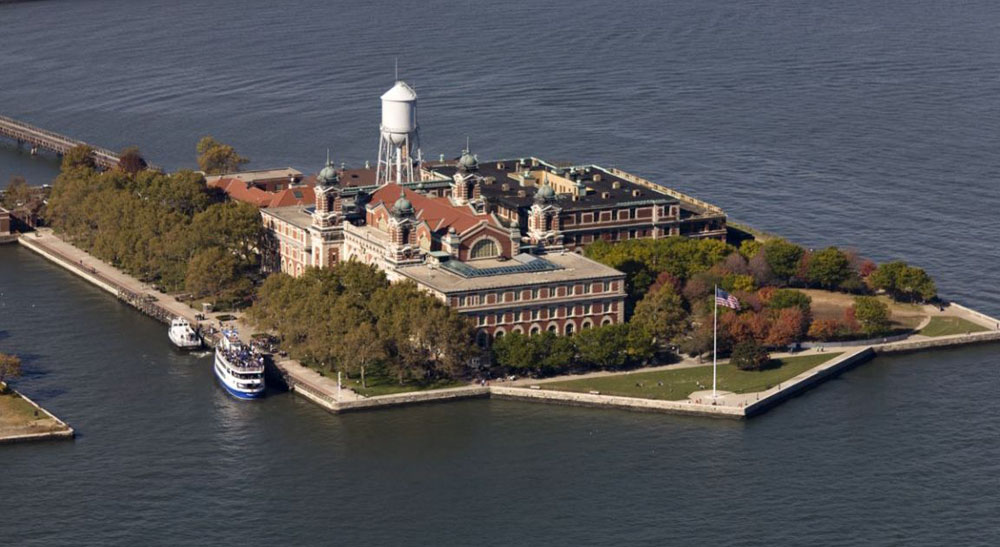
History
Ellis Island is the portal through which millions of immigrants entered the United States.It was opened in 1892 as a Federal Immigration station, a purpose it served for 60 years. Millions of immigrants passed through the station. Many came from eastern and southern Europe and many were escaping poverty and conflict.
Typically starting on horseback or train from cities and towns across Europe, these travellers had a long journey just to get to the seaport. They then boarded ships that were crowded, filled with a diverse group of up to 3,000 passengers all from different cultures and religions, and trekked across the Atlantic for 2 weeks
It is estimated that 40% of all current U.S citizens can trace at least one ancestor to Ellis Island.
What to do
Walk in the footsteps of the nation’s newest citizens as they travelled through the baggage, registry and hearing rooms — in some cases, leaving with new, "American" names.

History
Voted #1 attraction in New York City the huge museum complex comprises 28 interconnected buildings housing 45 permanent exhibition halls, in addition to a planetarium and a library. The museum collections contain over 33 million specimens of plants, animals, fossils, minerals, rocks, meteorites, human remains, and human cultural artefacts. Only a small fraction of these can be displayed at any given time. It occupies more than 2,000,000 square feet (190,000 m2). The museum has a full-time scientific staff of 225, sponsors over 120 special field expeditions each year, and averages about five million visits annually.
What to Do
Check out the dinosaur fossils and see the Planetarium space show and IMAX theatre.
Catch a show in the Hayden Planetarium and explore the rest of the Rose Centre for Earth and Space to learn more about the 13-billion-year history of the universe.
What to See
Thanks to its starring role in the film “Night at the Museum”, the most popular exhibit for children is the 94-foot (28.6 meters) blue whale and the fossilized skeleton of Tyrannosaurus Rex.
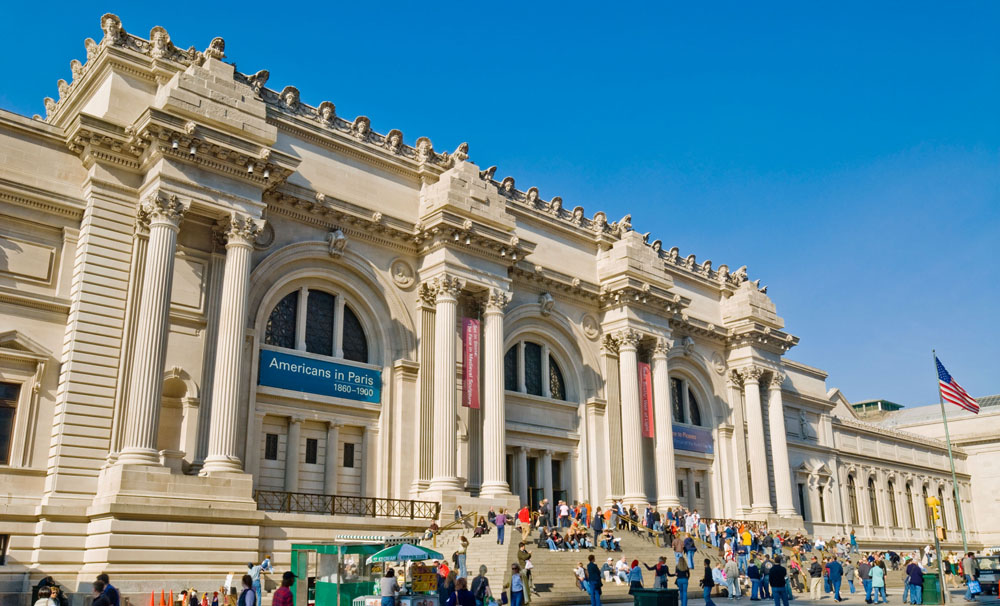
Known simply as "the Met," this museum offers an unparalleled view of the world, all under one roof. In total, the Met's collections include more than two million works of art that span over five thousand years of history.
What to Do
Enjoy its wide-ranging collection including Greek and Roman art, European and Asian paintings and sculptures, artefacts from Africa and the Americas, and more. If you are interested in medieval history then visit The Cloisters museum and gardens, a branch of the Met dedicated to the art of medieval Europe.
What to See
Of particular note is the ancient Egyptian collection established in 1906 — and the arms and armour holdings, which include examples from both Europe and Japan. The Met's collection of Egyptian art ranges from 300,000 B.C. to the 4th century A.D.
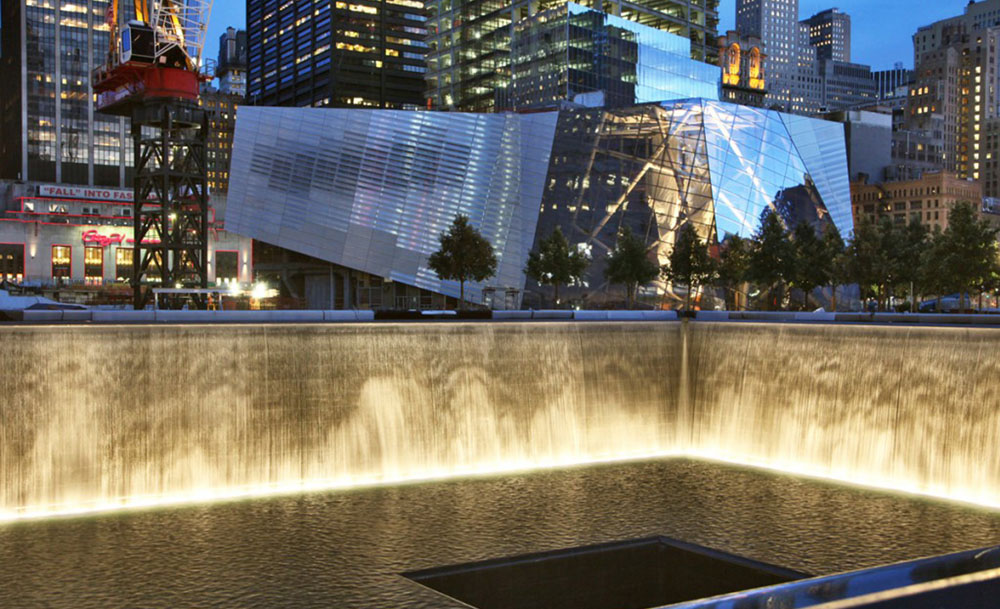
Experience a powerful reminder of the loss of life that occurred on that dreadful day.
What to See
See the historic "Survivor's Stairs", a remnant of the staircase through which hundreds escaped with their lives. Examine the background of the attacks, the story of what happened on 9/11, and the aftermath and continuing implications in the historical exhibition. Learn about some of the individual victims and their stories and see portraits of the nearly 3,000 men, women, and children who were killed in the attacks in the memorial exhibition.
What to Do
Enter the dramatic Foundation Hall, containing the "slurry wall", a surviving retaining wall of the original World Trade Centre, as well as the 36-foot-high "Last Column", covered with mementos, memorial inscriptions and missing posters.
Visit the twin reflecting pools sitting in the footprints of the Twin Towers that are each nearly an acre in size. Take time to wander around the 110,000-square feet of exhibition space in the museum. Some large artefacts including the "Survivor's Stairs" help tell the story of what happened on that day.
Surrounding the pools are the names of every person who died in the attacks inscribed in bronze. You'll also see the "Survivor Tree," a callery pear tree that was severely damaged at Ground Zero but was rehabilitated and now stands as a symbol of resilience, survival and rebirth. Seeing this memorial for yourself can have a profound effect on your visit to New York.
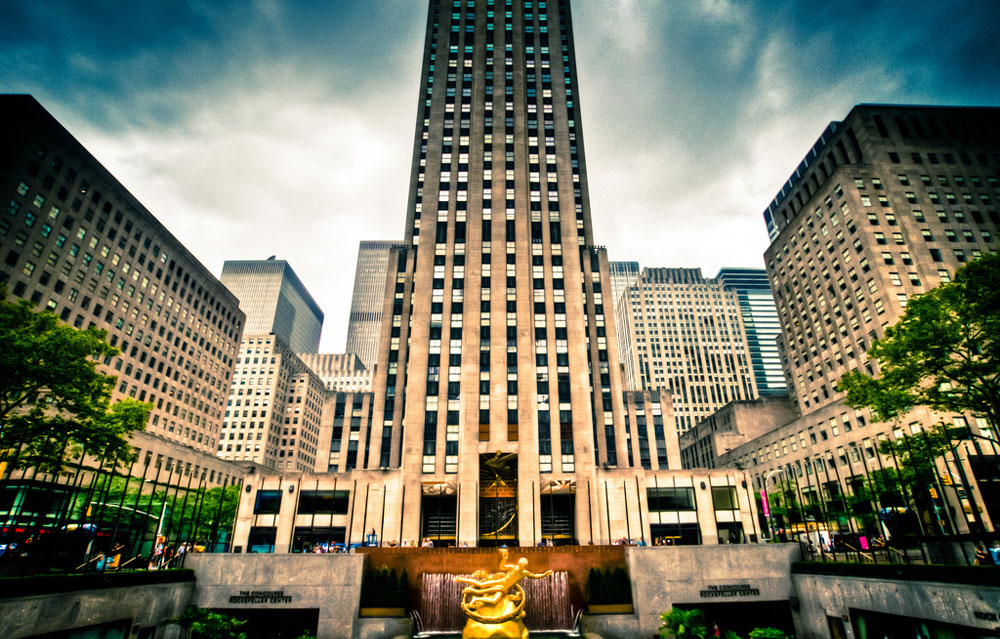
Rockefeller Center and Observation Deck
The Rockefeller Center is home to a remarkable collection of art deco motifs and sculptures signifying man’s development in spirit, science, industry and more.
History
Opened in May 1933 the Center was constructed during the Great Depression’s worst years with 40,000 people working on the site. With a grand lobby decorated by accomplished artists from Europe it was a bustling environment. It was the site where the idea for the famous film ‘Gone with the Wind’ was born. It has a tradition dating back to the 1930’s of erecting a huge Christmas Tree each year along with an ice skating rink.
An estimated million people walk through the centre every year and it is host to performances by pop groups, and live radio and TV shows.
What to Do
Explore some of the 24 acres (9.7 hectares) of underground shops and restaurants — those wanting a different view can head to the 'Top of the Rock' observation deck. Perched more than 800 feet (244 meters) above ground level and spanning three floors, the deck offers 360 degree views of the city. .
What to See
Top of the Rock is a three-level observation deck that consists of the 67th, 69th and 70th floors of 30 Rockefeller Plaza. The lower two floors have protective glass while the topmost level offers 360-degree, unobstructed views. There are also indoor viewing spaces with seating, art and light installations and gift shops on the 67th and 69th floors. With three floors of indoor and outdoor observation decks you'll have great views of many of New York's sights, especially if you use the sightseeing binoculars. On the 67th floor you can see the Radiance Wall, a wall of glass panels, blown glass, crystal clusters, and fiber-optic lighting created by Swarovski.

Central Park
Central Park is the most visited urban park in the United States, with over 40 million visitors a year, and one of the most filmed locations in the world.
The park was established in 1857 on 778 acres (315 ha) of land acquired by the city. In 1858, following a design competition, the park was improved and expanded. The park's first area was opened to the public in the winter of 1858. Construction north of the park continued during the American Civil War in the 1860s, and the park was expanded to its current size in 1873. In 1962 it was designated as a National Historic Landmark.
The park receives approximately 35 million visitors annually and is the most visited urban park in the United States. It is also the most filmed location in the world. A December 2017 report found that 231 movies have used Central Park for on-location shoots. The park has its own New York City Police Department precinct, the Central Park Precinct, which employs both regular police and auxiliary officers and now reports fewer than one hundred crimes per year (down from approximately 1,000 annually in the early 1980s).
While much of the planting and land form in the park appear natural, it is in fact almost entirely landscaped. The park contains several natural-looking lakes and ponds that have been created artificially by damming natural seeps and flows. There is a large area of woods in addition to seven major lawns, the "meadows", and many minor grassy areas. Some of them are used for informal or team sports and some are set aside as quiet areas. There are a number of enclosed playgrounds for children. The 6 miles (9.7 km) of drives within the park are used by joggers, cyclists, skateboarders, and inline skaters, especially when automobile traffic is prohibited, at weekends and in the evenings after 7:00 pm
What to Do
Visitors can walk, run, ride bicycles, play chess and checkers, ice skate, and even fish. Designated quiet zones accommodate those seeking tranquillity, while the 21 playgrounds are a boon for families with children who need to move!
What to See
Offering a welcome respite from the hustle and bustle of the city streets that surround it on all sides, the park is a refreshing year-round sanctuary. Central Park has been featured in more than 300 different films.

Times Square
History
Originally known as Long Acre Square after London’s carriage district, Times Square served as the early site for William H. Vanderbilt’s American Horse Exchange. In the late 1880s, Long Acre Square consisted of a large open space surrounded by drab apartments. Soon, however, the neighbourhood began to change. Electricity, in the form of theatre advertisements and street lights, transformed the public space into a safer, more inviting environment. Likewise, the construction of New York’s first rapid transit system, the Interborough Rapid Transit Company (IRT), gave New Yorkers unprecedented mobility in the city. Located in Midtown Manhattan at the intersection of Broadway and Seventh Avenue, Times Square has often been referred to as The Crossroads of the World. With its flashing neon lights and giant digital billboards, brilliant Broadway marquees, costumed characters and musicians, Times Square is big, bright and unforgettable. Its main junction is filled with popular retailers - plus the discount booth, which offers up to 50 percent off theatre tickets. Walk to the top of its red steps for a sweeping view of the area, including 'One Times Square', the building from which the ball drops on New Year's Eve.
What to See and Do
Times Square is now a pedestrian area. On New Year’s Eve, a million people swarm the square, waiting hours to watch the famed ball drop. Daily, thousands come in search of half-price Broadway show tickets, to people watch, or just stand, jaws dropped, to admire the 37-foot-high (11.3 meter) NASDAQ sign — the largest LED sign in the world!
